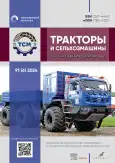Топологическая оптимизация рабочего оборудования фронтального погрузчика
- Авторы: Попов Ю.Г.1
-
Учреждения:
- Ярославский государственный технический университет
- Выпуск: Том 91, № 6 (2024)
- Страницы: 713-722
- Раздел: Теория, конструирование, испытания
- URL: https://bakhtiniada.ru/0321-4443/article/view/283046
- DOI: https://doi.org/10.17816/0321-4443-630455
- ID: 283046
Цитировать
Полный текст
Аннотация
Обоснование. Топологическая оптимизация широко применяется в авиастроении и архитектуре, но все ещё ограниченно используется в тяжёлом машиностроении. Вместе с тем, раскрой металла для производства рабочих органов, рам и других конструкций повсеместно осуществляется методом плазменной резки на станках с числовым программным управлением. Указанное обстоятельство позволяет получать плоские детали практически любой сложности. В свою очередь, это делает возможным использование методов топологической оптимизации без необходимости применять аддитивные технологии для создания трёхмерных конструкций.
Цель работы — снижение массы силовых деталей рабочего оборудования фронтального погрузчика без потери жёсткости и прочности, по сравнению с традиционными конструкциями и изучение возможностей топологической оптимизации для выполнения поставленной задачи.
Методы. В качестве базовой машины использовался погрузчик DM-30. Рабочее оборудование машины преобразовывалось в набор проектных объёмов плоской формы, к которым применялись методы топологической оптимизации пакета Autodesk Inventor Professional (AIP). Поскольку металлоконструкция рабочего оборудования испытывает в процессе эксплуатации переменные нагрузки, действующие в разных направлениях, был использован метод последовательной генерации форм деталей для каждого расчётного положения с последующим синтезом всех форм в один объект. Силы, действующие на элементы рабочего оборудования, определялись при помощи динамического моделирования расчётных положений для базовой машины, что позволило рассмотреть большинство рабочих ситуаций.
Результаты. В итоге массу рабочего оборудования фронтального погрузчика удалось снизить на 36%, при сохранении прочностных характеристик.
Заключение. Предложенная методика формирования оптимизированной металлоконструкции позволяет использовать простые модули топологической оптимизации и получать до 40% менее металлоёмкие пространственные конструкции.
Полный текст
Открыть статью на сайте журналаОб авторах
Юрий Германович Попов
Ярославский государственный технический университет
Автор, ответственный за переписку.
Email: popovyug@ystu.ru
ORCID iD: 0000-0002-7594-6234
SPIN-код: 7378-0410
канд. техн. наук, доцент кафедры «Строительные и дорожные машины»
Россия, ЯрославльСписок литературы
- Mee C. Mycenaean Fortifications, Highways, Dams and Canals. By R. Hope Simpson and D. K. Hagel. Am. J. Archaeol. 2007;111(2):374–375. doi: 10.1086/AJS40037280
- Ghabraie K. Applications of Topology Optimization Techniques in Seismic Design of Structure. In: Structural Seismic Design Optimization and Earthquake Engineering. IGI Global; 2012:232–268. doi: 10.4018/978-1-4666-1640-0.ch010
- Yuksel O. An overview on topology optimization methods employed in structural engineering. Kırklareli Univ. J. Eng. Sci. 2019:159-175. doi: 10.34186/klujes.606666
- Bendsøe MP, Sigmund O. Topology Optimization. Springer Berlin Heidelberg; 2004. doi: 10.1007/978-3-662-05086-6
- Meng L., Zhang W., Quan D., et al. From Topology Optimization Design to Additive Manufacturing: Today’s Success and Tomorrow’s Roadmap. Arch Comput Methods Eng. 2020;27(3):805–830. doi: 10.1007/s11831-019-09331-1
- Turner C, Gordon B, Mansfield N, Sayah A. Computer-Aided Design (CAD) Trends in Manufacturing for 2022. Technical report, 2022. doi: 10.13140/RG.2.2.11813.78566
- Boyarkina I.V. Technological mechanics of single-bucket front-end loaders. Omsk: SibADI; 2011. (In Russ.)
- Tsavdaridis KD, Kingman JJ, Toropov V V. Application of structural topology optimisation to perforated steel beams. Comput Struct. 2015;158:108–123. doi: 10.1016/j.compstruc.2015.05.004
- Tyflopoulos E, Steinert M. Messing with boundaries — quantifying the potential loss by pre-set parameters in topology optimization. Procedia CIRP. 2019;84:979–985. doi: 10.1016/j.procir.2019.04.307
- Tyflopoulos E, Tollnes FD, Steinert M, et al. State of the art of generative design and topology optimization and potential research needs. In: DS 91 Proc Nord 2018, Linköping, Sweden, 14th–17th August 2018. Linköping, 2018.
- Barroqueiro B, Andrade-Campos A, Valente RAF. Designing Self Supported SLM Structures via Topology Optimization. J Manuf Mater Process. 2019;3(3):68. doi: 10.3390/jmmp3030068
- Fiebig S., Sellschopp J., Manz H., et al. Future challenges for topology optimization for the us-age in automotive lightweight design technologies. In: Proc. of 11th world congress on structural and multidisciplinary optimization, Sydney, Australia. Sydney; 2015;142.
- Li Y, Yang Q, Chang T, Qin T, et al. Multi-load cases topological optimization by weighted sum method based on load case severity degree and ideality. Adv Mech Eng. 2020;12(8). doi: 10.1177/1687814020947510
- Oest J, Lund E. Topology optimization with finite-life fatigue constraints. Struct Multidiscip Optim. 2017;56(5):1045–1059. doi: 10.1007/s00158-017-1701-9
- Ribeiro TP, Bernardo LFA, Andrade JMA. Topology Optimisation in Structural Steel Design for Additive Manufacturing. Appl Sci. 2021;11(5):2112. doi: 10.3390/app11052112
- ZHU J, ZHOU H, WANG C, et al. A review of topology optimization for additive manufacturing: Status and challenges. Chinese J Aeronaut. 2021;34(1):91-110. doi: 10.1016/j.cja.2020.09.020
- Frantsuzov AA, Shapovalov YI, Vdovin DS. Topology optimization for lifting appliances design. Univ proceedings Volga Reg Tech Sci. 2017;42(2):99–108. (In Russ.) doi: 10.21685/2072-3059-2017-2-9
Дополнительные файлы


















